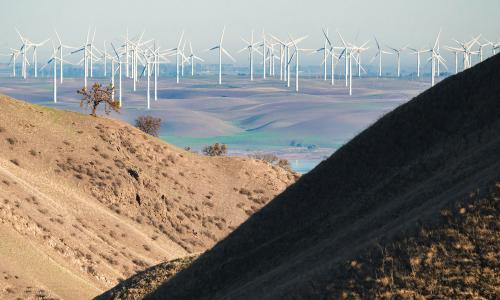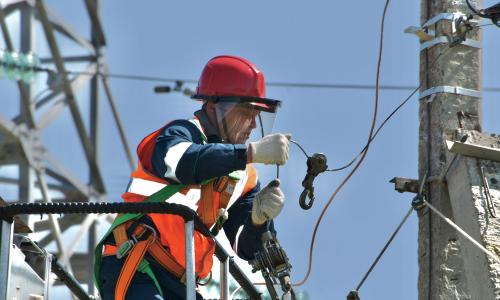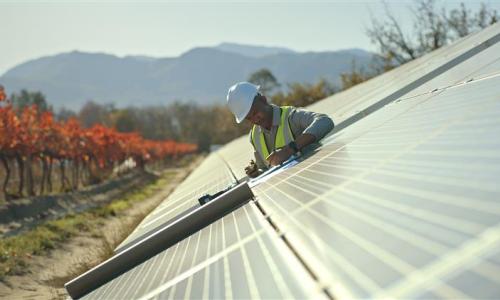Table of Contents
A large-scale solar photovoltaic (PV) power plant may have hundreds of thousands or even millions of solar panels.
Like rooftop solar, large-scale PV projects use photovoltaic cells arranged into panels. But while a rooftop system may consist of dozens of panels, a single large-scale project may have hundreds of thousands or even millions. For example, the 290 MW Agua Caliente project in Yuma County, AZ, involves 4.9 million solar panels [1]. Large PV systems are also more likely to have their panels rotate during the day to track the sun in order to increase electricity generation, by 40 percent or more [2].
While rooftop solar is the most visible piece of the solar revolution, large-scale systems have been a major part of PV’s growth in recent years. Large-scale PV systems accounted for more than half of all solar capacity installed from 2010 to 2014, with overall capacity quadrupling from 2012 to 2014 [3].
The economic benefits of scale
The cost of large-scale PV, like that of rooftop solar, has dropped dramatically in recent years. Electricity from new large PV projects in 2013 was half as expensive on average as in 2010, bringing their costs much closer to the wholesale prices set by natural gas or other power plant options [4].
These reductions are driven in large part by economies of scale as well as technological improvements and lower-priced panels manufactured in China. The result is falling solar panel prices, inverter prices, and “soft costs” related to sales, permitting inspection, connection to the electricity grid, and the profit margins of retailers and installers.
In addition, large-scale solar projects accrue fewer of these soft costs per unit of installed capacity compared to rooftop systems. As a result, the total cost for a given amount of solar in large projects is on average half that of residential solar, even with added costs such as mounting structures and engineering.
Large-scale PV projects can add to job growth in numerous areas including manufacturing, construction, operations, maintenance, and siting. And solar projects create more jobs than a comparable fossil fuel plant because a larger share of the project expenditure goes towards more labor-intensive activities such as manufacturing equipment, installation, and maintenance instead of fuel extraction and transportation [5].
As a result the U.S. solar industry employed more than 170,000 workers in 2014, adding workers at nearly 20 times the rate of the overall economy [6], and was investing almost $15 billion in the U.S. economy annually [7].
The environmental profile of large-scale solar
Unlike the fossil fuels that still provide the bulk of the U.S. power supply, solar panels generate electricity with no air or carbon pollution, no ash or other waste products, and no inputs other than sunlight. While the manufacturing of solar panels, like all other energy devices, involves emissions, PV electricity generation itself:
- generates no carbon dioxide or other heat-trapping gases that contribute to climate change [8]
- produces none of the other harmful emissions or wastes associated with coal power, such as mercury, sulfur dioxide, nitrogen oxides, lead, and arsenic [9]
- creates none of the long-lasting waste or environmental risks associated with nuclear power [10]
- avoids the environmental risks associated with natural gas, including potential water pollution during extraction [11]
What’s more, PV electricity generation involves little to no water. That stands in contrast to almost all power plants that make electricity using steam. These include coal and nuclear plants, many natural gas plants, and some other renewable energy facilities, which depend on water for cooling, causing problems when cooling water becomes too scarce or too hot. PV systems, in contrast, require no water to make electricity [12].
Large-scale solar projects can present challenges, however, with regard to the land area that they occupy—challenges common to all large construction projects. To produce enough electricity to make a large-scale system viable a project may need several acres of land for each megawatt of installed solar capacity [13]. In all environments—plains, deserts, and mountains alike—large PV projects can have impacts on important plant and animal habitats and can pose threats to cultural and archeological sites. And large solar projects require transmission lines, which can present their own environmental challenges [14].
Disruptions can be avoided, minimized, or mitigated by careful site selection and project design, robust analysis of environmental and cultural impacts, and other efforts before, during, and after project construction. In San Luis Obispo County, CA, for example, cooperation between state and federal resource agencies and the developers of large-scale solar in grassland areas helped protect habitat for the endangered San Joaquin kit fox and giant kangaroo rat [15].
Another approach to minimizing impacts is to locate projects on already degraded lands or marginal farmland [16]. Closed landfills host an increasing number of mid-sized projects, given the appropriateness of such sites for solar, the challenge in using the sites for other purposes, and the sites’ proximity to towns and cities. A six-megawatt project completed in 2014 at the Dennis landfill on Massachusetts’ Cape Cod, for example, meets a large portion of the local municipal electricity needs [17]. Forty-seven acres of the former New York City Freshkills landfill on Staten Island, NY—once the largest landfill in the world—is being turned into a 10 MW solar farm [18].
The policy environment of large-scale PV
Several types of well-crafted state and federal policies have helped accelerate the development of large-scale PV:
- Renewable electricity standards. A key driver of large-scale renewable energy development across the country has been legislation requiring utilities to get specific amounts or percentages of their electricity sales from renewable energy by certain dates. Twenty-nine states and the District of Columbia have enacted such renewable electricity standards, and eight other states have set renewable energy goals [19].
- Solar carve-outs. In some states carve-outs require a certain portion of utilities’ compliance with the renewable electricity standard to come from solar, or multipliers give extra compliance credit for solar investments.
- Tax policies. A federal investment tax credit helps to cover a portion of the cost of large systems (currently 30 percent). The federal tax code has also improved the economics of large-scale solar by allowing accelerated depreciation for solar equipment; the 2010 federal stimulus bill provided for even faster depreciation for projects built through 2014 [20]. Some state and local governments provide sales and property tax exemptions to help lower the cost to system owners [21].
- Permitting reforms. Efforts by local, state, and federal agencies to improve the permitting process can help to reduce the significant time and cost for all parties involved. Large solar systems often require permits at both the state and local levels. Projects to be located on federal property also involve federal land and wildlife agencies.
References:
[1] Department of Energy (DOE). No date. NRG Solar, LLC (Agua Caliente).
[2] Greentech Media (GTM). 2012. Solar balance-of-system: To track or not to track, part I. Boston, MA.
[3] Solar Energy Industries Association (SEIA). 2014e. Solar Market Insight Report 2014 Q2.
[4] Pierce, E.R. 2014. Progress report: Advancing solar energy across America. Washington, DC: Department of Energy.
[5] Union of Concerned Scientists (UCS). 2009. UCS Clean Power Green Jobs Factsheet.
[6] The Solar Foundation. 2015. National solar jobs census 2014. Washington, DC.
[7] GTM Research and Solar Energy Industries Association (SEIA). 2014c. U.S. residential solar PV installations exceeded commercial installations for the first time in Q1 2014. May 28.
[8] Dell, J., S. Tierney, G. Franco, R.G. Newell, R. Richels, J. Weyant, and T.J. Wilbanks. 2014. Energy supply and use. In Climate change impacts in the United States: The third national climate assessment. Washington, DC: U.S. Global Change Research Program.
[9] Freese, B., S. Clemmer, and A. Nogee. 2008. Coal power in a warming world: A sensible transition to cleaner energy options. Cambridge, MA: Union of Concerned Scientists.
[10] Gronlund, L., D. Lochbaum, and E. Lyman. 2007. Nuclear power in a warming world: Assessing the risks, addressing the challenges. Cambridge, MA: Union of Concerned Scientists.
[11] Union of Concerned Scientists (UCS). 2014a. How natural gas works: Water use and pollution.
[12] Averyt, K., J. Fisher, A. Huber-Lee, A. Lewis, J. Macknick, N. Madden, J. Rogers, and S. Tellinghuisen. 2011. Freshwater use by U.S. power plants: Electricity’s thirst for a precious resource. Cambridge, MA: Union of Concerned Scientists.
[13] Ong, S., C. Campbell, P. Denholm, R. Margolis, and G. Heath. 2013. Land use requirement of solar power plants in the United States. Golden, CO: National Renewable Energy Laboratory.
[14] Avian Power Line Interaction Committee (APLIC). 2014. Protecting birds and providing reliable electricity.
[15] Moler, R. 2013. Protecting wildlife and creating renewable energy on the Carrizo Plain. Sacramento, CA: U.S. Fish and Wildlife Service. Online at http://www.fws.gov/sacramento/outreach/Featured-Stories/ RenewableEnergy-CarrizoPlain/RenewableEnergy-CarrizoPlain.htm.
[16] Environmental Protection Agency (EPA). 2014. Re-powering America’s land: Siting renewable energy on potentially contaminated lands, landfills, and mine sites. Washington, DC.
Huntley, C. 2012. Brownfields can reduce pressure on sensitive lands. The Wilderness Society.
[17] Dennis, Massachusetts (Dennis). 2014. Dennis solar farm.
Solar Energy Industries Association (SEIA). 2015. Massachusetts Solar Industry Continues Strong Growth.
[18] New York City (NYC). 2013. Mayor Bloomberg announces city’s largest solar energy installation to be built at Freshkills Park in Staten Island. November 25.
[19] DSIRE 2015
[20] Solar Energy Industries Association (SEIA). 2014c. Depreciation of solar energy property in MACRS. Washington, DC.
[21] Database of State Incentives for Renewables and Efficiency (DSIRE). 2014f. Property tax incentives.
Database of State Incentives for Renewables and Efficiency (DSIRE). 2014g. Sales tax incentives.



